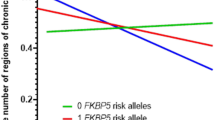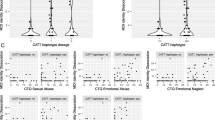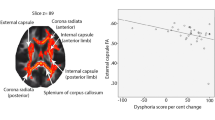Abstract
Alterations in the microarchitecture of the posterior cingulum (PC), a white matter tract proximal to the hippocampus that facilitates communication between the entorhinal and cingulate cortices, have been observed in individuals with psychiatric disorders, such as depression and post-traumatic stress disorder (PTSD). PC decrements may be a heritable source of vulnerability for the development of affective disorders; however, genetic substrates for these white matter abnormalities have not been identified. The FKBP5 gene product modulates glucocorticoid receptor function and has been previously associated with differential hippocampal structure, function, and affect disorder risk. Thus, FKBP5 is an attractive genetic target for investigations of PC integrity. We examined associations between PC integrity, measured through diffusion tensor imaging (DTI) and fractional anisotropy (FA; an index of white matter integrity), and polymorphisms in the FKBP5 SNP rs1360780 in a sample of 82 traumatized female civilians. Findings indicated that, compared with individuals without this allele, individuals who carried two ‘risk’ alleles for this FKBP5 SNP (T allele; previously associated with mood and anxiety disorder risk) demonstrated significantly lower FA in the left PC, even after statistically controlling for variance associated with age, trauma exposure, and PTSD symptoms. These data suggest that specific allelic variants for an FKBP5 polymorphism are associated with decrements in the left PC microarchitecture. These white matter abnormalities may be a heritable biological marker that indicates increased vulnerability for the development of psychiatric disorders, such as PTSD.
Similar content being viewed by others
Log in or create a free account to read this content
Gain free access to this article, as well as selected content from this journal and more on nature.com
or
References
Acheson DT, Gresack JE, Risbrough VB. (2012). Hippocampal dysfunction effects on context memory: possible etiology for posttraumatic stress disorder. Neuropharmacology 62: 674–685.
Almli LM, Fani N, Smith AK, Ressler KJ. (2013). Genetic approaches to understanding post-traumatic stress disorder. Int J Neuropsychopharmacol (e-pub ahead of print 8 October 2013).
Alonso G (2000). Prolonged corticosterone treatment of adult rats inhibits the proliferation of oligodendrocyte progenitors present throughout white and gray matter regions of the brain. Glia 31: 219–231.
Bernstein DP, Fink L. (1998) Childhood Trauma Questionnaire: a Retrospective Self-Report Manual. The Psychological Corporation: New York, NY, USA.
Bevilacqua L, Carli V, Sarchiapone M, George DK, Goldman D, Roy A et al (2012). Interaction between FKBP5 and childhood trauma and risk of aggressive behavior. Arch Gen Psychiatry 69: 62–70.
Binder EB (2009). The role of FKBP5, a co-chaperone of the glucocorticoid receptor in the pathogenesis and therapy of affective and anxiety disorders. Psychoneuroendocrinology 34 (Suppl 1): S186–S195.
Binder EB, Bradley RG, Liu W, Epstein MP, Deveau TC, Mercer KB et al (2008). Association of FKBP5 polymorphisms and childhood abuse with risk of posttraumatic stress disorder symptoms in adults. JAMA 299: 1291–1305.
Boscarino JA, Erlich PM, Hoffman SN, Zhang X. (2012). Higher FKBP5, COMT, CHRNA5, and CRHR1 allele burdens are associated with PTSD and interact with trauma exposure: implications for neuropsychiatric research and treatment. Neuropsychiatr Dis Treat 8: 131–139.
Bradley RG, Binder EB, Epstein MP, Tang Y, Nair HP, Liu W et al (2008). Influence of child abuse on adult depression: moderation by the corticotropin-releasing hormone receptor gene. Arch Gen Psychiatry 65: 190–200.
Bremner JD, Randall P, Scott TM, Bronen RA, Seibyl JP, Southwick SM et al (1995). MRI-based measurement of hippocampal volume in patients with combat-related posttraumatic stress disorder. Am J Psychiatry 152: 973–981.
Bremner JD, Vermetten E, Afzal N, Vythilingam M. (2004). Deficits in verbal declarative memory function in women with childhood sexual abuse-related posttraumatic stress disorder. J Nerv Ment Dis 192: 643–649.
Bremner JD, Vythilingam M, Vermetten E, Southwick SM, McGlashan T, Nazeer A et al (2003). MRI and PET study of deficits in hippocampal structure and function in women with childhood sexual abuse and posttraumatic stress disorder. Am J Psychiatry 160: 924–932.
Chen L, Chen X, Liu W, Wang Q, Jiang T, Wang J et al (2013). White matter microstructural abnormalities in patients with late-onset schizophrenia identified by a voxel-based diffusion tensor imaging. Psychiatry Res 212: 201–207.
Chiang MC, Avedissian C, Barysheva M, Toga AW, McMahon KL, de Zubicaray GI et al (2009). Extending genetic linkage analysis to diffusion tensor images to map single gene effects on brain fiber architecture. Med Image Comput Comput Assist Interv 12 (Pt 2): 506–513.
Choi J, Jeong B, Rohan ML, Polcari AM, Teicher MH (2009). Preliminary evidence for white matter tract abnormalities in young adults exposed to parental verbal abuse. Biol Psychiatry 65: 227–234.
Collip D, Myin-Germeys I, Wichers M, Jacobs N, Derom C, Thiery E et al (2013). FKBP5 as a possible moderator of the psychosis-inducing effects of childhood trauma. Br J Psychiatry 202: 261–268.
Delano-Wood L, Stricker NH, Sorg SF, Nation DA, Jak AJ, Woods SP et al (2012). Posterior cingulum white matter disruption and its associations with verbal memory and stroke risk in mild cognitive impairment. J Alzheimers Dis 29: 589–603.
Drago V, Babiloni C, Bartres-Faz D, Caroli A, Bosch B, Hensch T et al (2011). Disease tracking markers for Alzheimer's disease at the prodromal (MCI) stage. J Alzheimers Dis 26 (Suppl 3): 159–199.
Falsetti SA, Resnick HS, Resick PA, Kilpatrick DG. (1993). The modified PTSD symptom scale: a brief self-report measure of posttraumatic stress disorder. Behav Ther 16: 161–162.
Fani N, Gutman D, Tone EB, Almli L, Mercer KB, Davis J et al (2013). FKBP5 and attention bias for threat: associations with hippocampal function and shape. JAMA Psychiatry 70: 392–400.
Fani N, King TZ, Jovanovic T, Glover EM, Bradley B, Choi K et al (2012). White matter integrity in highly traumatized adults with and without post-traumatic stress disorder. Neuropsychopharmacology 37: 2740–2746.
Fujiwara H, Namiki C, Hirao K, Miyata J, Shimizu M, Fukuyama H et al (2007). Anterior and posterior cingulum abnormalities and their association with psychopathology in schizophrenia: a diffusion tensor imaging study. Schizophr Res 95: 215–222.
Gilbertson MW, Gurvits TV, Lasko NB, Orr SP, Pitman RK. (2001). Multivariate assessment of explicit memory function in combat veterans with posttraumatic stress disorder. J Trauma Stress 14: 413–432.
Gurvits TV, Shenton ME, Hokama H, Ohta H, Lasko NB, Gilbertson MW et al (1996). Magnetic resonance imaging study of hippocampal volume in chronic, combat-related posttraumatic stress disorder. Biol Psychiatry 40: 1091–1099.
Hua K, Zhang J, Wakana S, Jiang H, Li X, Reich DS et al (2008). Tract probability maps in stereotaxic spaces: analyses of white matter anatomy and tract-specific quantification. Neuroimage 39: 336–347.
Ising M, Depping AM, Siebertz A, Lucae S, Unschuld PG, Kloiber S et al (2008). Polymorphisms in the FKBP5 gene region modulate recovery from psychosocial stress in healthy controls. Eur J Neurosci 28: 389–398.
Jenkinson M, Smith S. (2001). A global optimisation method for robust affine registration of brain images. Med Image Anal 5: 143–156.
Kantarci K, Senjem ML, Avula R, Zhang B, Samikoglu AR, Weigand SD et al (2011). Diffusion tensor imaging and cognitive function in older adults with no dementia. Neurology 77: 26–34.
Kazlouski D, Rollin MD, Tregellas J, Shott ME, Jappe LM, Hagman JO et al (2011). Altered fimbria-fornix white matter integrity in anorexia nervosa predicts harm avoidance. Psychiatry Res 192: 109–116.
Kim SJ, Jeong DU, Sim ME, Bae SC, Chung A, Kim MJ et al (2006). Asymmetrically altered integrity of cingulum bundle in posttraumatic stress disorder. Neuropsychobiology 54: 120–125.
Klengel T, Mehta D, Anacker C, Rex-Haffner M, Pruessner JC, Pariante CM et al (2013). Allele-specific FKBP5 DNA demethylation mediates gene-childhood trauma interactions. Nat Neurosci 16: 33–41.
Kochunov P, Glahn DC, Lancaster JL, Winkler AM, Smith S, Thompson PM et al (2010). Genetics of microstructure of cerebral white matter using diffusion tensor imaging. Neuroimage 53: 1109–1116.
Lavebratt C, Aberg E, Sjoholm LK, Forsell Y. (2010). Variations in FKBP5 and BDNF genes are suggestively associated with depression in a Swedish population-based cohort. J Affect Disord 125: 249–255.
Lebel C, Gee M, Camicioli R, Wieler M, Martin W, Beaulieu C. (2012). Diffusion tensor imaging of white matter tract evolution over the lifespan. Neuroimage 60: 340–352.
Luijk MP, Velders FP, Tharner A, van Ijzendoorn MH, Bakermans-Kranenburg MJ, Jaddoe VW et al (2010). FKBP5 and resistant attachment predict cortisol reactivity in infants: gene-environment interaction. Psychoneuroendocrinology 35: 1454–1461.
Ly M, Canu E, Xu G, Oh J, McLaren DG, Dowling NM et al (2013). Midlife measurements of white matter microstructure predict subsequent regional white matter atrophy in healthy adults. Hum Brain Mapp (e-pub ahead of print 17 July 2013; doi:10.1002/hbm.22311).
Mackey AP, Whitaker KJ, Bunge SA. (2012). Experience-dependent plasticity in white matter microstructure: reasoning training alters structural connectivity. Front Neuroanat 6: 32.
Mehta D, Gonik M, Klengel T, Rex-Haffner M, Menke A, Rubel J et al (2011). Using polymorphisms in FKBP5 to define biologically distinct subtypes of posttraumatic stress disorder: evidence from endocrine and gene expression studies. Arch Gen Psychiatry 68: 901–910.
Metzler-Baddeley C, Jones DK, Steventon J, Westacott L, Aggleton JP, O'Sullivan MJ. (2012). Cingulum microstructure predicts cognitive control in older age and mild cognitive impairment. J Neurosci 32: 17612–17619.
Morimoto M, Morita N, Ozawa H, Yokoyama K, Kawata M (1996). Distribution of glucocorticoid receptor immunoreactivity and mRNA in the rat brain: an immunohistochemical and in situ hybridization study. Neurosci Res 26: 235–269.
Paillere Martinot ML, Lemaitre H, Artiges E, Miranda R, Goodman R, Penttila J et al (2013). White-matter microstructure and gray-matter volumes in adolescents with subthreshold bipolar symptoms. Mol Psychiatry (e-pub ahead of print 30 April 2013; doi:10.1038/mp.2013.44).
Scharf SH, Liebl C, Binder EB, Schmidt MV, Muller MB (2011). Expression and regulation of the Fkbp5 gene in the adult mouse brain. PLoS One 6: e16883.
Schermuly I, Fellgiebel A, Wagner S, Yakushev I, Stoeter P, Schmitt R et al (2010). Association between cingulum bundle structure and cognitive performance: an observational study in major depression. Eur Psychiatry 25: 355–360.
Scholz J, Klein MC, Behrens TE, Johansen-Berg H. (2009). Training induces changes in white-matter architecture. Nat Neurosci 12: 1370–1371.
Shin LM, Liberzon I. (2010). The neurocircuitry of fear, stress, and anxiety disorders. Neuropsychopharmacology 35: 169–191.
Smith SM, Jenkinson M, Johansen-Berg H, Rueckert D, Nichols TE, Mackay CE et al (2006). Tract-based spatial statistics: voxelwise analysis of multi-subject diffusion data. Neuroimage 31: 1487–1505.
Smith SM, Jenkinson M, Woolrich MW, Beckmann CF, Behrens TE, Johansen-Berg H et al (2004). Advances in functional and structural MR image analysis and implementation as FSL. Neuroimage 23 (Suppl 1): S208–S219.
Smith SM. (2002). Fast robust automated brain extraction. Hum Brain Mapp 17: 143–155.
Sylvester CM, Corbetta M, Raichle ME, Rodebaugh TL, Schlaggar BL, Sheline YI et al (2012). Functional network dysfunction in anxiety and anxiety disorders. Trends Neurosci 35: 527–535.
Thomason ME, Thompson PM (2011). Diffusion imaging, white matter, and psychopathology. Annu Rev Clin Psychol 7: 63–85.
Tromp do PM, Grupe DW, Oathes DJ, McFarlin DR, Hernandez PJ, Kral TR et al (2012). Reduced structural connectivity of a major frontolimbic pathway in generalized anxiety disorder. Arch Gen Psychiatry 69: 925–934.
Vasterling JJ, Brailey K, Constans JI, Sutker PB. (1998). Attention and memory dysfunction in posttraumatic stress disorder. Neuropsychology 12: 125–133.
Vasterling JJ, Duke LM, Brailey K, Constans JI, Allain AN Jr., Sutker PB. (2002). Attention, learning, and memory performances and intellectual resources in Vietnam veterans: PTSD and no disorder comparisons. Neuropsychology 16: 5–14.
Wang HH, Zhang ZJ, Tan QR, Yin H, Chen YC, Wang HN et al (2010). Psychopathological, biological, and neuroimaging characterization of posttraumatic stress disorder in survivors of a severe coalmining disaster in China. J Psychiatr Res 44: 385–392.
Xie P, Kranzler HR, Poling J, Stein MB, Anton RF, Farrer LA et al (2010). Interaction of FKBP5 with childhood adversity on risk for post-traumatic stress disorder. Neuropsychopharmacology 35: 1684–1692.
Yehuda R, Keefe RS, Harvey PD, Levengood RA, Gerber DK, Geni J et al (1995). Learning and memory in combat veterans with posttraumatic stress disorder. Am J Psychiatry 152: 137–139.
Zeng LL, Shen H, Liu L, Wang L, Li B, Fang P et al (2012). Identifying major depression using whole-brain functional connectivity: a multivariate pattern analysis. Brain 135 (Pt 5): 1498–1507.
Zhang J, Wang J, Wu Q, Kuang W, Huang X, He Y et al (2011). Disrupted brain connectivity networks in drug-naive, first-episode major depressive disorder. Biol Psychiatry 70: 334–342.
Zhang Y, Schuff N, Jahng GH, Bayne W, Mori S, Schad L et al (2007). Diffusion tensor imaging of cingulum fibers in mild cognitive impairment and Alzheimer disease. Neurology 68: 13–19.
Zobel A, Schuhmacher A, Jessen F, Hofels S, von Widdern O, Metten M et al (2010). DNA sequence variants of the FKBP5 gene are associated with unipolar depression. Int J Neuropsychopharmacol 13: 649–660.
Acknowledgements
We thank the participants who made this work possible, as well as the staff of the Grady Trauma Project, particularly Allen W. Graham, Angelo Brown, Amreen Dharani, Jennifer S. Davis, Jennifer Winkler, Sarah Spann, and Andrew Pallos. We wish to thank Jaemin Shin and Timothy Ely for their valuable assistance with data analysis, and the Georgia State University—Georgia Institute of Technology Center for Advanced Brain Imaging for data support.
Author information
Authors and Affiliations
Corresponding author
Additional information
Supplementary Information accompanies the paper on the Neuropsychopharmacology website
Supplementary information
PowerPoint slides
Rights and permissions
About this article
Cite this article
Fani, N., King, T., Reiser, E. et al. FKBP5 Genotype and Structural Integrity of the Posterior Cingulum. Neuropsychopharmacol 39, 1206–1213 (2014). https://doi.org/10.1038/npp.2013.322
Received:
Revised:
Accepted:
Published:
Issue date:
DOI: https://doi.org/10.1038/npp.2013.322
Keywords
This article is cited by
-
SwinDTI: swin transformer-based generalized fast estimation of diffusion tensor parameters from sparse data
Neural Computing and Applications (2024)
-
Aberrant white matter microstructure evaluation by automated fiber quantification in typhoon-related post-traumatic stress disorder
Brain Imaging and Behavior (2023)
-
Altered white matter microstructural organization in posttraumatic stress disorder across 3047 adults: results from the PGC-ENIGMA PTSD consortium
Molecular Psychiatry (2021)
-
FKBP5 methylation predicts functional network architecture of the rostral anterior cingulate cortex
Brain Structure and Function (2020)
-
FKBP5 Moderates the Association between Antenatal Maternal Depressive Symptoms and Neonatal Brain Morphology
Neuropsychopharmacology (2018)



